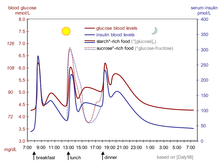| Impaired fasting glucose | |
|---|---|
| Other names | Impaired fasting glycemia, IFG |
 | |
| The fluctuation of blood sugar (red) and the sugar-lowering hormone insulin (blue) in humans during the course of a day with three meals. One of the effects of a sugar-rich vs a starch-rich meal is highlighted.[1] | |
Impaired fasting glucose is a type of prediabetes, in which a person's blood sugar levels during fasting are consistently above the normal range, but below the diagnostic cut-off for a formal diagnosis of diabetes mellitus.[2] Together with impaired glucose tolerance, it is a sign of insulin resistance. In this manner, it is also one of the conditions associated with metabolic syndrome.
Those with impaired fasting glucose are at an increased risk of vascular complications of diabetes, though to a lesser extent. The risks are cumulative, with both higher blood glucose levels, and the total amount of time it spends elevated, increasing the overall complication rate.
IFG can eventually progress to type 2 diabetes mellitus without intervention, which typically involves lifestyle modification. Those with impaired fasting glucose have a 1.5 fold increased risk of developing clinical diabetes within 10 years, when compared to the general population. Some studies suggest that without lifestyle changes, IFG will progress to clinically diagnosable diabetes in just under 3 years, on average.[3]
Impaired fasting glucose is often, though not always, associated with impaired glucose tolerance, though it may occur in isolation, with such persons having a normal response to a glucose tolerance test.
- ^ Daly ME, Vale C, Walker M, Littlefield A, Alberti KG, Mathers JC (June 1998). "Acute effects on insulin sensitivity and diurnal metabolic profiles of a high-sucrose compared with a high-starch diet" (PDF). The American Journal of Clinical Nutrition. 67 (6): 1186–96. doi:10.1093/ajcn/67.6.1186. PMID 9625092.
- ^ Thompson, Janice; Manore, Melinda; Sheeshka, Judy (2010), Nutrition a functional approach, Toronto, Ontaria: Pearson Canada, pp. 141–44
- ^ Nichols GA, Hillier TA, Brown JB (2007). "Progression From Newly Acquired Impaired Fasting Glusose to Type 2 Diabetes". Diabetes Care. 30 (2): 228–33. doi:10.2337/dc06-1392. PMC 1851903. PMID 17259486.